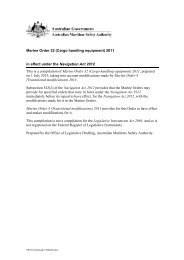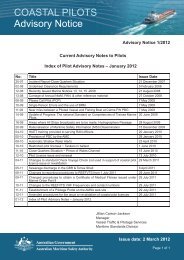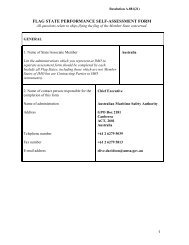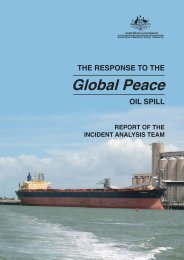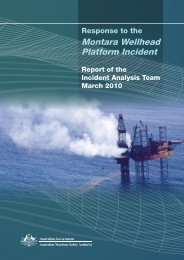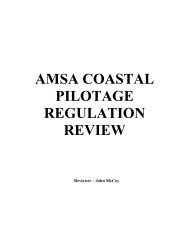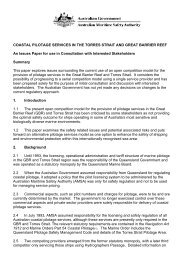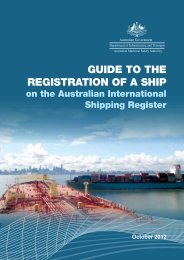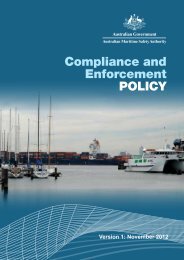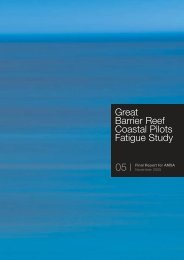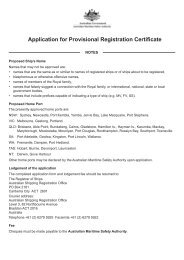Oil Spill Monitoring BACKGROUND PAPER - Australian Maritime ...
Oil Spill Monitoring BACKGROUND PAPER - Australian Maritime ...
Oil Spill Monitoring BACKGROUND PAPER - Australian Maritime ...
You also want an ePaper? Increase the reach of your titles
YUMPU automatically turns print PDFs into web optimized ePapers that Google loves.
<strong>Oil</strong> <strong>Spill</strong> <strong>Monitoring</strong>: Background Paper<br />
1.0 INTRODUCTION<br />
1.1 The Purpose of this Document<br />
The purpose of this Background Paper is to provide guidance about the nature,<br />
justifiable scope, and scale of post spill monitoring programmes. It focuses<br />
predominantly on post spill monitoring of oil spills, although the concepts presented<br />
are generally applicable to all types of marine spills.<br />
The Background Paper defines and discusses the rationale for classifying post spill<br />
monitoring into two general “types”: Operational (Type I) and Non-Operational or<br />
Scientific (Type II) monitoring. It explains the significance of these terms, addresses<br />
funding and cost recovery aspects, and describes the key design aspects that must<br />
be considered when establishing a monitoring programme.<br />
It directly supports the <strong>Oil</strong> <strong>Spill</strong> <strong>Monitoring</strong> Handbook (AMSA, 2003), which is<br />
designed to provide field guidance for the planning and execution of monitoring of oil<br />
spills for operational (response) purposes.<br />
1.2 Reasons for <strong>Monitoring</strong> <strong>Oil</strong> and Chemical <strong>Spill</strong>s, Response Actions and Effects<br />
<strong>Oil</strong> and chemical spills pose a threat to the environment, and the potential for<br />
damage, or the actual damage caused, is a major public concern. Indeed, the most<br />
often stated objective of spill response efforts is to protect the environment, or to<br />
minimise environmental damage. The term “environmental damage” includes shortterm<br />
and long-term effects on the natural, physical, economic and social environment<br />
(including risks to human health) that may be attributable to the spill or from<br />
subsequent spill response activities.<br />
To address the various concerns raised about the effects of a spill, and any<br />
associated cleanup response, some form of monitoring is usually required. <strong>Spill</strong><br />
monitoring has a very broad scope and includes all the procedures undertaken to<br />
obtain and process information relating to the behaviour and fate of a spill, its effects,<br />
and the effects of response activities.<br />
As the feedback provided by spill monitoring will directly influence the priorities,<br />
strategies and methods employed during a spill response, it is important that relevant,<br />
quantitative and accurate information is obtained and made available. For example,<br />
monitoring to ensure particular response activities are justifiable and/or effective need<br />
to show that:<br />
• Response efforts are directed at areas where the most oil/chemical has been<br />
spilled, and there is the greatest potential to recover spilt oil/chemical.<br />
• Protection and cleanup strategies are directed at the most sensitive areas or<br />
resources.<br />
• Cleanup strategies are effective and result in less damage than untreated oil or<br />
chemical.<br />
<strong>Monitoring</strong> may also be required for reasons not directly linked to the spill response.<br />
For example, the collection of information to calculate economic damages, to quantify<br />
environmental impact, to identify the source of the oil for prosecutions, or for purely<br />
scientific reasons.<br />
2



